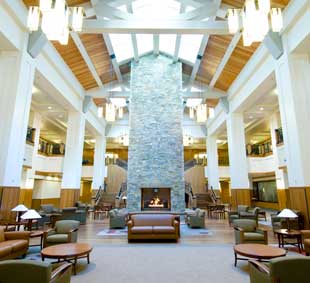 There’s been lots of chatter lately about the blurring lines between healthcare design and hospitality design. But I don’t think the lines are blurring. Here’s why.
There’s been lots of chatter lately about the blurring lines between healthcare design and hospitality design. But I don’t think the lines are blurring. Here’s why.
Hospitals aren’t hotels and never have been, nor never will be. The reasons patients stay overnight in hospitals are not the same reasons guests stay overnight in hotels.
While it’s good that many providers are using design and amenities to make the patient experience better, I don’t know a single healthcare designer who thinks he or she is doing hospitality design when working on a hospital project.
And, as far as I can tell, hospitality designers aren’t designing hospitals.
Actually, a hospitality designer worked on Peace Health Sacred Heart Hospital at Riverbend (above, left), which opened in Eugene, OR, a few years ago. But his main contribution was on the site plan, entrance, and main lobby.
The Future of Healthcare is Retail
For those who think the future of healthcare is hospitality, think again.
The future of healthcare is retail, as Marin Valins of Stantec Architecture wrote in May. He offers some interesting insights into the changing nature of healthcare that more aptly fits the retail model.
And while the trend is toward more clinic-based care, new hospitals being built today have many retail features.
Bridgepoint Hospital, a 464-bed complex care and rehab facility that opened in Toronto last June, is accessible to the public with walking and bike paths. Its “Urban Porch” has a Tim Hortons coffee, Shoppers Drug Mart, library, and access to two outdoor terraces.
(Read more about Bridgepoint, which was designed by two teams of architects — Stantec Architecture/KMPB Architects and HDR Architecture/Diamond Schmitt Architects — in the November issue of Healthcare Design magazine.)
Also, if a hospital looks or feels more like a hotel or a retail store, is that bad? As the Fable Hospital story illustrates, adding features that improve patient satisfaction and quality of care actually can help reduce the cost of healthcare. After all, healthcare design has never been just about making things look pretty.
P.S. Please do me a favor — if you liked this post and like this blog, please share it with others by sending them the link and/or post it on your Twitter, LinkedIn, or Facebook, etc. Also, don’t forget to subscribe, so you’ll get emails when new content is posted. Thanks!
If you like this post, please share.

What’s my story? I’m a healthcare and senior living design knowledge expert who writes and speaks frequently about trends and issues affecting these two industries. I’m also a strategic marketing consultant and content creator, working with companies and organizations who want to improve the quality of healthcare and senior living through the design of the physical environment. You can reach me at sara@saramarberry.com.


5 Responses
This confusion has been around at least 30 years, since I started with Planetree on patient-centered design.
The other points I feel are important about healthcare not being hospitality or retail is:
1) We need equity of access to healthcare, there are ethical questions involved about who gets care, and what quality of care. Do we let some go bankrupt or even die if they can’t afford to “make the purchase” of care?
The model must not be “you get what you can afford”- so we are content that some get a Honda Civic and others a Mercedes sedan, nor is it you “stay where can afford” – some at a Motel 6, others at a Fairmont.
2) Patient education is an essential component of effective healthcare. Educational activity is not part of a retail or hospitality design model but is at the core of Triple Aim healthcare – high quality, effective and cost efficient, and accessible.
Great points, Marc. So many think that good design costs more, so it can’t be equitable in healthcare. But it’s really a shift in thinking — hospitals serving poor populations can still have environments that are supportive and healing.
Hospital Design does not have to cost a lot. Yes, you can make it look like a hotel, but there is no need to do so, you can still get good hospital design (sensible) within a budget, have it look good but not look like a hotel, there is no need to. And architects and designers have a lot to answer to in this area, as they can waste clients money and time, in making their designs too fancy when there is no need to! Its the patient that comes first in hospital design. You are not there for lunch, dinner and a nice bed to sleep in for a holiday, you are there because you are not well! Architects need to spend less time making fancy models on Revit, which is time consuming to the client. The construction manager on site does not give rats backside about 3D; all he requires is flat 2d plans and elevations. The 3D model is a concept and something to keep the architectural graduate busy in the office and to show a client what the concept will look like when finished! So why do so many architects waste so much time on models, when really the construction documents are all 2d flat plans that could be done just as easy on Autocad. We are going too far towards 3D drawings at the cost of the client and the cost of projects and at the cost of patients who cannot afford to go to these places any longer. We should not be giving separate services for those that can afford and those that cannot afford it. Hospital design should be for everyone regardless. Affordable design for all concerned.
3D Models are needed for review of the 2D cross-trade drawing’s interaction. I have seen this correct errors before construction begins too many times. So this actually saves money. As for hospitals being designed as hotel space. The real question is “What is the patients expectation?” With the expectation of “equity” has come the expectation that people should get more than what is paid for. That has caused more problems in a common day than any other. A hospital’s construction team has to find a middle ground between the reality of cost and the predicted path of expectation. The current trend in larger rooms and natural finishes seems good, but is it where we need to go? Patient driven design is only so good. We need to look at where we are going in the expectations of health care. I for one, do not see equity as the path for the future. We are already going to the “VP” mind set of most rooms being equal but not all. More bell-and-whistles for the VP is the “expectation” for a portion of current designs. Will this expand to govern entire floors in hospitals? We are already seeing boutique hospitals mentioned in the press. Is this where we want to be going? Only time will tell.
Thanks, James, for your comments. I think your thoughts about equity are interesting. There have always been haves and have nots in our society.